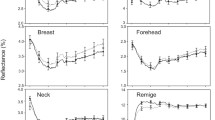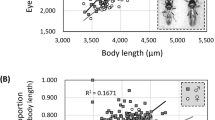Abstract
We experimentally tested the hypothesis that sexual dichromatism in the subspecies of Eulemur fulvus is the evolutionary result of female preference for brightly colored males. Ten female lemurs representing 6 different subspecies of Eulemur fulvus were subjects in the experiment; controls were 4 females of non-sexually dichromatic lemurid taxa. For each taxon we presented photographs of the face of a male of that taxon whose colors had been digitally altered to make him less and more colourful. Median viewing times of the pooled female Eulemur fulvus are significantly correlated with colorfulness. Viewing times in the control females are not correlated with color or brightness of the stimulus photographs. We concluded that the females of the Eulemur fulvus sspp. preferred to view photographs of more colorful males, which is consistent with the predictions of sexual selection theory.
Similar content being viewed by others
References
Andersson, M. (1982). Female choice selects for extreme tail length in a widowbird. Nature 299: 818-820.
Andersson, M. (1994). Sexual Selection, Princeton University Press, Princeton, NJ.
Badyaev, A. V., and Hill, G. E. (2000). Evolution of sexual dichromatism: Contribution of carotenoid-versus melanin-based coloration. Biol. J. Linn. Soc. 69: 153-172.
Bierens De Haan, J. A., and Frima, M. J. (1930). Versuche ueber den Farbensinn der Lemuren. Z. Vergl. Physiol. 12: 603-631.
Blakeslee, B., and Jacobs, G. H. (1985). Colour vision in the ring-tailed lemur (Lemur catta). Brain Behav. Evol. 26: 154-166.
Bovet, D., and Vauclair, J. (2000). Picture recognition in animals and humans. Behav. Brain Res. 109: 143-165.
Coss, R. G. (1978). Perceptual determinants of gaze aversion by the lesser mouse lemur (Microcebus murinus), the role of two facing eyes. Behaviour 64: 248-270.
Cuthill, I. C., Bennett, A. T. D., Partridge, J. C., and Maier, E. J. (1999). Plumage reflectance and the objective assessment of avian sexual dichromatism. Am. Nat. 153: 183-200.
Darwin, C. (1871). The Descent of Man, and Selection in Relation to Sex, John Murray, London.
Dixson, A. F. (1998). Primate Sexuality, Oxford University Press, Oxford.
Emery, N. J. (2000). The eyes have it: The neuroethology, function and evolution of social gaze. Neurosci. Biobehav. Rev. 24: 581-604.
Fisher, R. A. (1930). The Genetical Theory of Natural Selection, Clarendon Press, Oxford.
Gerald, M. (2001). Primate color predicts social status and aggressive outcome. Anim. Behav. 61: 559-566.
Gosset, D., and Roeder, J-J. (2000). Colour and shape discrimination in black lemurs (Eulemur macaco). Folia Primatol. 71: 173-176.
Hamilton, W. D., and Zuk, M. (1982). Heritable true fitness and bright birds: A role for parasites? Science 218: 384-387.
Harvey, P. W., and Bradbury, J. W. (1991). Sexual selection. In Krebs, J. R., and Davies, N. B. (Eds.). Behavioural Ecology: An Evolutionary Approach, 3rd edn., Blackwell Scientific Publications, Oxford, pp. 203-233.
Jacobs, G. H., and Deegan, J. F. (1993). Photopigments underlying color vision in ringtail lemurs (Lemur catta) and brown lemurs (Eulemur fulvus). Am. J. Primatol. 30: 243-256.
Kappeler, P. M. (1990). The evolution of sexual size dimorphism in prosimian primates. Am. J. Primatol. 21: 201-214.
Kappeler, P. M. (1996). Intrasexual selection and phylogenetic constraints in the evolution of sexual canine dimorphism in strepsirhine primates. J. Evol. Biol. 9: 43-65.
Kappeler, P. M. (2000). Causes and consequences of unusual sex ratios among lemurs. In Kappeler, P. M. (ed.), Primate Males: Causes and Consequences of Variation in Group Composition, Cambridge University Press, Cambridge, UK, pp. 55-63.
Mittermeier, R. A., Tattersall, I., Konstant, W. R., Meyers, D. M., and Mast, R. B. (1994). Lemurs of Madagascar, Conservation International, Washington, DC.
Ostner, J., and Kappeler, P. M. (1999). Central males instead of multiple pairs in redfronted lemurs, Eulemur fulvus rufus (Primates, Lemuridae)? Anim. Behav. 58: 1069-1078.
Overdorff, D. J. (1998). Are Eulemur species pair-bonded? Social organisation and mating strategies in Eulemur fulvus rufus from 1988–1995 in southeast Madagascar. Am. J. Phys. Anthropol. 105: 153-166.
Paul, A. (2002). Sexual selection and mate choice. Int. J. Primatol. 23: 877-904.
Pereira, M. E., and Kappeler, P. M. (1997). Divergent systems of agonistic behaviour in lemurid primates. Behaviour 134: 225-274.
Pereira, M. E., and McGlynn, C. (1997). Special relationships instead of female dominance for redfronted lemurs, Eulemur fulvus rufus. Am. J. Primatol. 43: 239-258
Pereira, M. E., and Weiss, M. L. (1991). Female mate choice, male migration, and the threat of infanticide in ringtailed lemurs. Behav. Ecol. Sociobiol. 28: 141-152.
Petrie, M., Halliday, T. R., and Sanders, C. (1991). Peahens prefer peacocks with elaborate trains. Anim. Behav. 41: 323-331.
Regan, G. (1998). The Evolution of Pelage Colouration in Primates, PhD Thesis, University of Durham, Durham. UK.
Setchell, J. M., and Dixson, A. F. (2001). Changes in the secondary sexual adornments of male mandrills (Mandrillus sphinx). are associated with gain and loss of alpha status. Horm. Behav. 39: 177-184.
Shedd, D. H., and Macedonia, J. M. (1991). Metachromism and its phylogenetic implications for the genus Eulemur (Prosimii: Lemuridae). Folia Primatol. 57: 221-231.
Ulmer, F. A. (1964). Sexual dichromatism in the irides of Lemur catta. J. Mammal. 45: 490
Vick, L. G., and Pereira, M. E. (1989). Episodic targeting aggression and the histories of Lemur social groups. Behav. Ecol. Sociobiol. 25: 3-12.
Wimmer, B., and Kappeler, P. M. (2002). The effects of sexual selection and life history on the genetic structure of redfronted lemur, Eulemur fulvus rufus, groups. Anim. Behav. 64: 557-568.
Zahavi, A. (1975). Mate selection—A selection for a handicap. J. Theor. Biol. 53: 205-214.
Author information
Authors and Affiliations
Corresponding author
Rights and permissions
About this article
Cite this article
Cooper, V.J., Hosey, G.R. Sexual Dichromatism and Female Preference in Eulemur fulvus Subspecies. International Journal of Primatology 24, 1177–1188 (2003). https://doi.org/10.1023/B:IJOP.0000005986.21477.ad
Issue Date:
DOI: https://doi.org/10.1023/B:IJOP.0000005986.21477.ad




